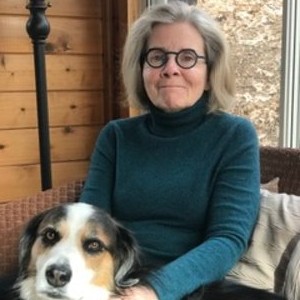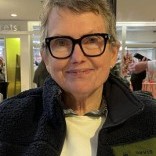The Real Thing
Patricia Dwyer
“What you call love was invented by guys like me . . . to sell nylons.” You might recognize this as one of Don Draper’s iconic, and perhaps more cynical lines, in Mad Men, the acclaimed TV series depicting the advertising culture of the 1950s and 60s. Don is a master of the artful slogan for big brands: Playtex, Jaguar, Pond’s Cold Cream, and dozens of others. Sure, he was out to sell the girdle, a vehicle, and creamy lotion. But with Don’s clever turns of phrase, consumers were really buying a more desirable figure, the elitism of a luxury car, or the beauty of a moisturized complexion.
In advertising, things weren’t always as they seemed. I know, because my father was a “mad man” too.
~
Born in 1951, I grew up watching my father, dressed in suit and tie, head off to catch the train to downtown Philadelphia where he worked at Gray and Rogers advertising agency. I knew his job had something to do with writing; on occasion we’d hear about a product tagline or jingle he had created. A memorable one for a once-elegant, now-defunct hotel in Atlantic City: “Haddon Hall: The only thing we overlook is the ocean.”
I came to understand much later in life that my father’s Haddon Hall slogan was part of a new phase in advertising that occurred during this period. Before this, advertisers relied on the product’s quality. If the Ford Mustang or Swanson TV Dinner or Frigidaire frost-free refrigerator was well made, consumers bought them. But as high standards became more ubiquitous, agencies had to differentiate their clients’ goods from their competitors. Advertisers promoted a product’s “unique selling point” or “unique value proposition” to distinguish their clients’ products in the marketplace. How was the item different, i.e. better? What could its market advantage add to the cost? And how could a perceived value be created through image, language, or both? The quintessential example was the Lucky Strike cigarette ad, produced shortly after the Surgeon General declared tobacco harmful to health: “Everyone else’s tobacco is poisonous. Lucky Strike’s is ‘toasted.’”
But “unique value” wasn’t just about the products that advertisers promoted. Advertising firms themselves showcased their own unique selling point or value proposition in order to succeed in the highly competitive market created by the newest way to reach consumers: television. Agencies attracted clients based on their ability to present a product as more desirable, more profitable, more essential. My father, who went into advertising because he was a brilliant writer and believed in promoting well-made goods, never fit into the fast-paced, appearance-driven culture that advertising was becoming.
~
Each January 17th my parents celebrated their wedding anniversary at Philadelphia’s Poor Richard’s Club, a legendary hub for journalists and advertisers in the 1950’s and 60’s. My mother would dress up in a fancy gown, and my father in his rented tuxedo, to attend the club’s annual “ball” at the Bellevue-Stratford in center city. My younger sister and I would watch as my mother dabbed her cheeks with rosy-pink rouge, applied bright red lipstick, and slipped on the dress du jour, taffeta or velvet, sequined or silk, and always floor length. As my parents emerged from their bedroom, we flashed the family Polaroid camera like reporters at a red-carpet event. My father appeared tall, serious looking with piercing blue eyes; my mother dazzled, with jet black hair and a smile that could have advertised toothpaste. Our “instant” photos magically developed right before our eyes. We watched as their images went from yellow to purple, and gradually filled in with greens and reds, a feat of chemical reactions that produced the perfect picture of glamour and success.
~
In the 1960s, advertisers began exploring the psychology behind spending. Rather than highlighting the product’s quality, ads promised an experience. After World War II, the economy boomed, with middle class expansion and suburban housing developments on the rise. Consumers had the money to purchase luxuries in addition to necessities. Think slogans like “See the USA in a Chevrolet” or United’s “Fly the Friendly Skies.” Agencies leveraged consumers’ pent-up desire for material comfort or adventure after years of austerity and war. Thus, modern branding was born.
Did my father’s “brand” for Haddon Hall—exquisite service and a room with a view—become reality for every hotel guest? Probably not. But the possibility drew them in and kept them coming.
~
Each Christmas season, my parents took us into the city to visit Santa and watch the Wanamaker department store’s spectacular light show. Afterwards, we would have lunch at Horn and Hardart Automat just around the corner from my dad’s office. The restaurant sparkled with red-lacquered tables and polished-silver metal legs. Gleaming black and white floor tiles became a giant checkerboard. The restaurant’s four walls were lined with small windows that resembled post office boxes, with bright headings overhead, each with a different graphic: soups, salads, sandwiches, and desserts. My father would take a pile of nickels from his pocket and distribute some to each of us. We ran from window to window, elated at so many choices. Egg salad, Salisbury steak, grilled cheese, and fried chicken! Poking coins through the slots next to our favorite, we turned a knob, the door popped open, and there was our ready-made meal! The whole experience was like a magic show and culinary extravaganza rolled into one.
After retrieving our tuna salad sandwich or vegetable soup, almost instantly, a pair of rubber-gloved hands filled the empty space with a freshly made look-alike. The disembodied body parts were strange, even eerie. We’d sometimes catch a glimpse of a person behind the wall, typically a woman with a hair net and nimble fingers. That hidden part of the restaurant seemed quite drab compared to our technicolor experience on the other side. I’m pretty sure that the sandwich was not nearly as good as my mother’s, and the soup was probably watered down, but it was the experience that stayed with me.
~
In our family, appearance was important. With upward mobility more accessible, and the advertising industry permeating airwaves with products that promised a more successful, more attractive, more sophisticated persona, who wouldn’t take the bait? We were the quintessential middle-class family living the typical suburban life. Two-story home with a stone façade and gardens on either side; a small brick patio in the back where our three-foot plastic pool was assembled each summer; and lots of neighborhood kids with bicycles and roller skates. Church was a big part of our lives. Each Sunday, as if on cue, we filed into a long pew that accommodated all seven of us, almost always on time, except when my sisters or I couldn’t find the church-required veil. For the parish’s annual summer carnival, my mother made a pound cake for the bake sale and my father ran the beanbag stand. My siblings and I attended the local parish school from first through eighth grades. As far as the exemplary Catholic family went, we were the perfect advertisement: large and devoted.
But my experience at home was missing part of that public-facing sheen. My father, a devoted parent but also a strict disciplinarian, had a temper that could flare. He came out of the “spare the rod and spoil the child” approach to child-rearing. As a result, I tended to be well-behaved and compliant. In high school, I had my occasional unruly escapade, a raucous night on the town or a broken curfew. But when it came to religion, I pretty much colored within the sacramental lines. The worst I ever did was skip Mass on Sunday when my friends and I rented a room in Ocean City, NJ, for a weekend. I felt guilty about it for weeks.
Right after high school, I entered the Sisters of St. Joseph, becoming a nun in 1969, just as civil rights demonstrations and feminist ideologies were on the rise. I saw the convent as my chance to be part of a noble cause, to join a religious community that served the poor and worked against injustice. Admired by the students and respected by friends and family, I lived in communities with other nuns, held leadership positions, and presented myself as the ideal candidate for Sisterhood. But something wasn’t right.
I found myself drawn romantically to women. Having taken a vow of chastity, I knew that any romantic relations were forbidden. Even worse, homosexual attractions were considered sinful. In the mid-80s, just as I was sorting through my own internal conflicts, the Vatican published an official statement on homosexuals, designating them as “intrinsically disordered.” There were so many strikes against “coming out.” Jeopardizing my family’s reputation was one thing, but defying the Catholic Church, the institution that was a cornerstone of my life, felt like a betrayal. But if I were to be honest with myself, what I feared most was damage to my image—the “mad man” in me that needed to sustain the illusion of a perfectly fulfilled and devoted Catholic nun. My value proposition.
As a result, I carefully curated the information I was willing to share. Only with a few close friends could I be more honest. Secrecy felt safer. That translated into more superficial relationships, especially with my family members. Of course, I loved my father, and I know he believed in and loved me too. But well beyond childhood, even at ages 25, 30, and 35, I felt the need to please him, to not disappoint. I projected the image he wanted of me, or maybe it was the image I simply imagined he wanted.
For almost ten years, I see-sawed between emotional highs and lows, at times content about my place in the church and world, and at times, despondent over what I saw as a betrayal. After months of counseling and prayer, I decided to take a step back and figure out who I was. In 1991, I requested a leave of absence from the Sisters. During the following year, I came out as a lesbian.
~
Pain points in advertising are typically attributed to customers: The price to too high. I didn’t get the service I wanted. The quality isn’t what I expected. But my father had his own tipping point, one that was more related to disillusionment than disappointment. He dedicated his life’s work to an industry that gradually passed him over for a slicker, glitzier version of the successful advertising executive. After joining a different agency as vice president, my father became more removed from the creative side of the business and more mired in the managerial headaches. Whenever his new colleague stopped by our house to drop off paperwork, I noticed how much younger, more sophisticated and modern he looked compared to my father. Starched cuffs and collars and stylish gem-studded cuff links. One day he even wore a pink dress shirt! My father, in contrast, stuck to his traditional dark suits, white shirts, and striped ties. Even as a young girl, I could see the difference. I wondered if he’d ever catch up.
I was oblivious to my dad’s promotions but recognized that he was getting home later and later. I remember his somber conversations with my mother behind closed doors when his business partner and friend left the agency, breaking with professional norms and taking several lucrative clients with him. My father’s work-related pressures were compounded by an already melancholic and private temperament. Over time, he began sleeping a lot, often all Saturday afternoon. My mother would remind us to stay quiet. Your father needs rest, she would say. If it weren’t for his beloved Philadelphia Eagles’ games, he probably would have done the same on Sunday.
A few years before my father had planned to retire, he was forced to take a leave of absence for colon cancer surgery. When he returned to the agency, probably before he had fully recovered, he discovered that many of his clients had been assigned to other executives. Talk of agency mergers were on the horizon, and the pension he had accrued during his long career evaporated into the cloud of empty promises he had counted on for retirement.
~
In 1984, my father died of colon cancer at 67 years of age. By that time, Poor Richard’s Club—the host of all those ritzy galas he and my mother had attended—was defunct. The ad agency to which he’d devoted the latter part of his career had closed its doors. As an adult, I often felt resentment, even disappointment, in my father’s career choice, one that didn’t suit his disposition. I thought he should have been a teacher or something more “authentic.” I blamed advertising’s stress for his gloomy moods. But I’ve come to realize that despite the industry’s changes that made him feel so out of step, he didn’t have much choice. He supported a family of seven. In the 50s and 60s, he was expected to project the image of the accomplished male and head of the household. My dad didn’t have the luxury to take that step back, to leave a profession to “sort things out,” that had been available to me. His family obligations and the lucrative position that supported us placed that option completely out of his reach. He stayed in advertising for us.
~
The Mad Men finale features Don Draper, after failed marriages, disappointing ad campaigns, and lost clients, seeking solace on a mountaintop surrounded by hippie-types singing the legendary Coca Cola theme song, “It’s the Real Thing.” Don sits cross-legged, Buddha-like, a serene smile on his face, perfectly satisfied with the remarkable brand that ostensibly he has created. While the refrain made for a catchy ad, Don never considered advertising to be the real thing. He knew it was inventing love by selling nylons.
My father’s ads promised experiences as well, but I believe he was committed to being as "real" as possible. I wonder how he dreamt up his Haddon Hall slogan: “The only thing we overlook is the ocean.” I would wager he took my mom to the storied hotel to spend a night, had a drink in their splendid lobby’s bar, chatted with guests, and dined at their luxurious restaurant. Knowing him, he would have wanted the ad to promise something as close to the real thing as possible.
My dad would have wanted that for me too. An honest life, not one spent presenting myself in one way while living another. He died several years before I came out as a lesbian, and I often wonder how that news would have settled with him. In 1991, probably not well. But I like to believe his love for me was larger, expansive enough to transcend a category, even if he didn’t quite understand it. He would have wanted me to be the real thing.



